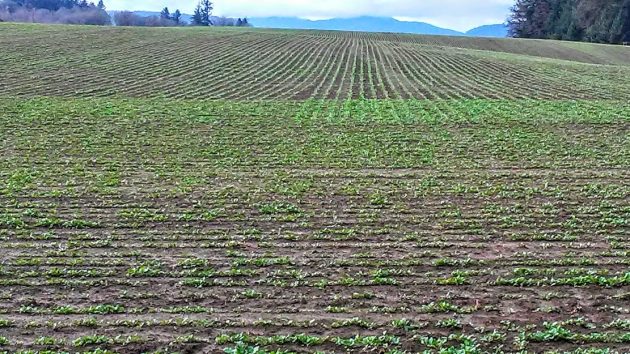
This used to be grass-seed field, but a different crop appears to be sprouting there now.
To a lifelong city dweller like me, almost all the things being grown beyond the outskirts of town are mystery crops. And so it was when I went on a short neighborhood bike ride before the Thanksgiving meal.
On a nearby field, I was pretty sure they grew ryegrass for seed in years past. So what was this new crop I saw coming up in neat rows all the way to the horizon?
With the help of someone better at Google searches than me, we found something that looked very much like my photo of the plants growing there:

It appears to be canola, or maybe its close relative in the brassica family, rapeseed, from which canola was hybridized in Canada several decades ago. (I didn’t know this until I looked it up just now.) (See the comments below for a more likely candidate.)
If this is right, neighbors and passersby are in for a visual treat come spring. That’s when this field should turn into a huge carpet of bright yellow flowers as far as the eye can see. (hh)

Imagine these rows becoming plants 3-5 feet tall and the whole field looking like a giant yellow rug.

Controversy:
https://civileats.com/2019/06/20/oregons-seed-war-can-vegetable-crops-and-canola-coexist-in-the-seed-capitol-of-america/
Not canola, it is most likely a turnip variety by the looks of the leaf.
Thanks! We’ve been wondering what that is that’s growing there.
Before I clicked on Mr. Cicada’s link I hadn’t realized we seed growers were involved in a war. Choosing not to engage, I did not join on that website and so could not read the contents of the article but, before I retreat to my bunker, I will offer some observations on cropping patterns in this part of the Willamette valley.
First, to Mr. Hering’s speculation on the crop in that field. It possibly could be Canola but the chances are better that it is a turnip crop being raised for seed.
If I remember correctly, the production of Canola in the Willamette valley is restricted as to locations and acreage by the Oregon Department of Agriculture.
A discussion of that, it is my guess, would link in to the “War” referenced in Mr. Cicada’s article and is a subject in itself.
At one point in the 1990’s the then 220,000 acres of cultivated ground in Linn county and a preponderance of farmed ground in Benton county were almost all in the production of grass for seed. The loss of field burning which increased the need for rotation crops, and the development of cover-cropping principally east of the Rockies, has provided the option for growers to crop other species to include brassicas. Canola is principally an oil seed and production is further limited in the valley due to the scarcity of oil seed processing facilities. On the other hand, turnips, which are fall planted and also bloom yellow in the spring, are processed through grass cleaning facilities and marketed through regular seed channels.
Another brassica grown locally is a daikon type radish that is spring planted and blooms white later in the year.
As with most of our neighbors, we have diversified from 100 percent grass seed productions in the 90’s to raising as many as nine different species, and multiple varieties of some, in any given year.
As usual, I’m grateful to my friends in agriculture, such as Don Wirth and George Pugh, to straighten me out when I venture into their field and, likely as not, get it wrong.